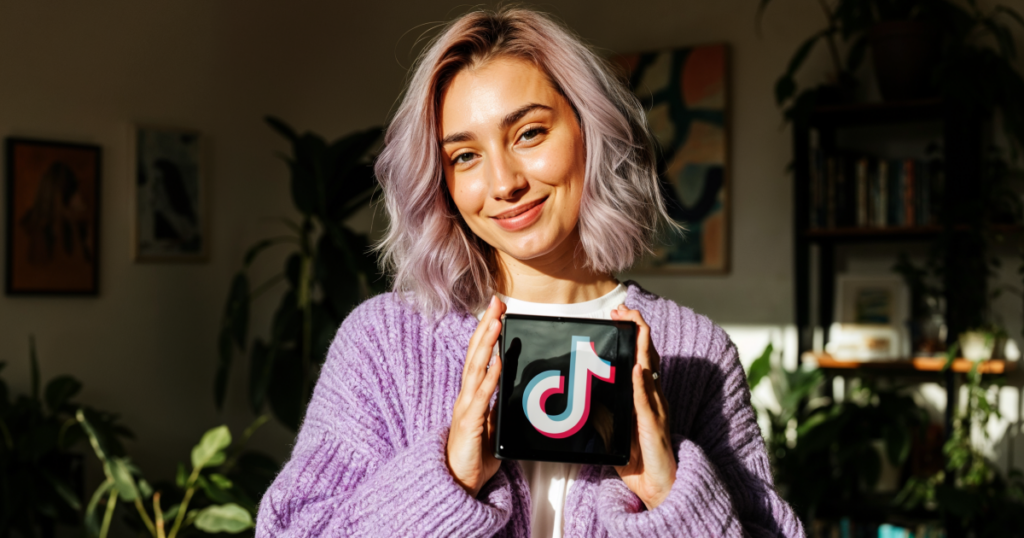You did it! You finally created a TikTok account! You did what people have likely told you to do for the past four years!
But seriously, no shade: we’re proud of you. It’s hard to adopt new technology, especially social media. And while TikTok isn’t entirely new anymore, we totally understand that it still feels like the Wild West.
Well, cowboy, where do you go now? Here’s a trail map to TikTok (okay, it’s a beginner’s guide, but we were sticking to the theme).
How to Create Your TikTok Account

Still figuring out how exactly to create your account? Here’s a quick overview:
- Download the TikTok app, which is available on iOS or Android.
- Hit “Sign Up.”
- Sign up using your email, phone number, or another social media account.
- Type in your info.
- Choose a username (Don’t worry — you can change this later.)
- Upload a profile picture that represents you.
- Write a bio that represents you.
- And you’re good to start exploring!
That’s your general run-of-the-mill TikTok account. But if you’re a business owner, you may want to create a Business Account. If you’ve already created an account, here’s how to turn it into a Business Account:
- In the app, click the three lines on the top right of the Profile page.
- Go to “Settings and privacy.”
- Click “Account.”
- Select “Switch to Business Account.”
But you may have plans to become a full-time content creator. In that case, you might want a Creator Account. To turn your account into a Creator Account, you would follow the steps outlined above, but switch it back to a Personal Account because a Personal Account and a Creator Account are the same thing.
If you’re unsure which one is best for you, check out this guide to decide if you need a Business or Personal Account.
What Am I Watching? Curating Your Feed

You have two feeds on TikTok: your For You page (FYP) and your Following feed. TikTok’s algorithm shows you random videos from around the world on the FYP based on your interests and interaction with similar videos. And it’s — frankly — scary accurate most of the time.
Your Following tab is who you choose to follow (duh). But how do you discover who to follow? On the bottom of the app, you’ll see Home, Discover, a plus sign in a rectangle, Inbox, and Profile. Home shows you your For You and Following feeds, while the Discover tab shows you what’s trending in the vast world of TikTok.
Posting Your First TikTok Video

Going back to that little plus sign at the bottom, that’s your moneymaker (eventually, when you get all those brand collabs and creator monetization money). It’s where you’ll be able to create your first TikTok video.
Set a maximum length for your video (or take a photo or post text content). Then tap the record button. Pressing that little button opens up your phone’s camera. You can film for 15 seconds, 60 seconds, or three minutes if you have an earlier version of the app, but some users report being able to film for up to 10 minutes on newer versions.
You’ll also see a list of icons on the side of the video.
- Flip (two arrows going in a circle) lets you go between your front and back camera.
- Flash (a lightning bolt) turns the flash on and off.
- Timer (a clock) sets an auto-record countdown, making hands-free filming much easier.
- Frame Size (two arrows pointing at each other) changes the video’s frame size (surprise).
- Retouch (a wand with sparkles around it) automatically cleans up blemishes and, with an AR filter, gives you a full face of makeup.
You can also add effects by scrolling through the effects on the bottom of the screen.
To add a specific sound from TikTok’s expansive music and sound library, you can tap the top of your recording screen to find available sounds. Find one you like? Hit “Use This Sound” at the bottom of the screen.
Do you like what you see (and hear)? It’s time to enhance it. Before you publish, you can add text overlays and filters, trim your clip down, or add a voiceover and voice effects.
Next, head to the Post page to prepare your first post for publication. On this page, you can add a caption and hashtags, tag other users, control the privacy settings, turn comments on or off, and share your post on other linked social media accounts. You can also allow a Stitch or a Duet.
Have you ever seen a video with a split screen showing one user reacting to another creator’s video? That’s a Duet. A Stitch is when a user takes up to five seconds of another creator’s video and adds it to their own.
Once your post is ready to go with the settings you want, click “Post,” and your video will be live on TikTok. (And saved to the device you used to create it.)
But Wait…Do I Have to Record on TikTok?

Nope! If you want a video longer than three minutes (or 10 minutes, depending on what your app has access to), you’ll need to record outside of TikTok. Instead of filming directly in the app, you can upload videos up to an hour long.
You should still hit the little plus sign at the bottom to upload a video. Then, instead of setting a maximum length for your video, you’ll hit the little picture square next to the record button to access your device’s library.
What Do My Analytics Mean?

So, now that you’ve started posting, how’s it going? No clue? Well, that’s where TikTok analytics comes in. To find your analytics:
- Open the app and go to “Profile.”
- Tap the three lines on the right-hand side.
- Go to “TikTok Studio.”
- Go to Analytics and click “View all.”
Here you’ll find five categories: Overview, Content, Viewers, Followers, and LIVE.
Over in Overview, you’ll see your post views, profile views, likes, comments, shares, the traffic sources people find you on, and the search queries people typed in to find your content. It also shows if you have any monetary rewards.
In Content, you can find your Top Posts and analytics, like which post has the most views or brought in the most new viewers.
Viewership is a breakdown showing how your viewership grows, plus insights like gender, age, and location. You’ll also see your viewers’ most active times of day (which is super helpful for finding the best time to post), other creators your viewers interact with, and other posts your viewers view.
In Followers, you get basic metrics to start, like your follower growth, follower insights, and most active times of day, but you’ll get more in-depth information once your follower count goes beyond 100 people.
LIVE is a newer part of TikTok that lets viewers and creators interact in real time. The LIVE tab in your TikTok analytics shows your number of live videos, total live views, total live time, new viewer count, new followers, unique viewers, and Diamonds (a type of reward you can get from Gifts on your live videos, exchangable for real money).
How Do I Get Engagement?

And now, perhaps the most important question, “How the heck do I get people to watch my stuff?” Here are some best practices to boost engagement as a TikTok newbie.
1. Create a consistent posting schedule
TikTok recommends posting one to four times daily, but tbh, you probably don’t need to. Rival IQ’s TikTok Benchmark Report for 2024 found that most brands post about twice a week while influencers tend to post an average of 1.79 times per week.
Starting out, you might want to go a bit higher to get more views and engagement, but having a consistent posting schedule is more important than throwing a bunch of TikTok videos at the wall and hoping something sticks. Instead of the spaghetti method, consider when you post by looking at the active times of your viewers and followers.
2. Interact with your audience
Engagement is still king. If you want people to engage with you, the law of the land on TikTok is that you should engage. You can make videos directly replying to a comment on a previous video, or you can Stitch or Duet other creators. If you make an effort to be a part of the community on TikTok, you’re more likely to be welcomed into said community with higher engagement.
(A note for the future: Manual interactions to keep your engagement rate up become impossible as you grow. That’s when it’s time for TikTok automation!)
3. Take part in trends
A big part of TikTok is its trends or “Challenges.” These Challenges aren’t always worth getting into (some are downright dangerous), but other Challenges are simply fun dances to try. Challenges typically don’t have a high barrier to entry (fancy way of saying, “You don’t need to be a professional dancer to do them”), which means that they’re accessible to a lot of creators.
You can try to create your own Challenge, but this is better left to established creators, as they’re more likely to have their Challenge go viral.
4. Find your niche, and sprinkle in some SEO
Gone are the days of Google’s reign! More than 40% of Americans now use TikTok as a search engine. So, how can that help you get discovered?
The first thing you want to do is narrow down the type of content you want to produce. Then, research what other creators in this niche do for content and how they caption it. You might also head to Google Trends to get some ideas for keywords for your captions. (Since it’s going off of Google Analytics, you don’t need to use these keywords verbatim, but they can be a good jumpstart.)
Search engine optimization (SEO) on TikTok can help the platform’s features better categorize your content. And having that content in the right category helps TikTok recommend your content to the right people.
Need some content inspiration? Here’s a little creator inspo for viral video ideas.
Get Ready to Launch Your New TikTok Career

With these handy tips, you now have a perfect starting place to begin your TikTok channel. Once you start growing, are you ready for what comes next when everybody wants a piece of you? Don’t worry — Manychat is here to save the day with TikTok automation!
With Manychat’s TikTok automation features, you can have your audience message any keyword, and Manychat will handle the rest with quick replies and no work for you. Or you can set up automatic triggers to start conversations with your fans the second someone messages you.
Like we said, you want engagement, you gotta give it, too!














